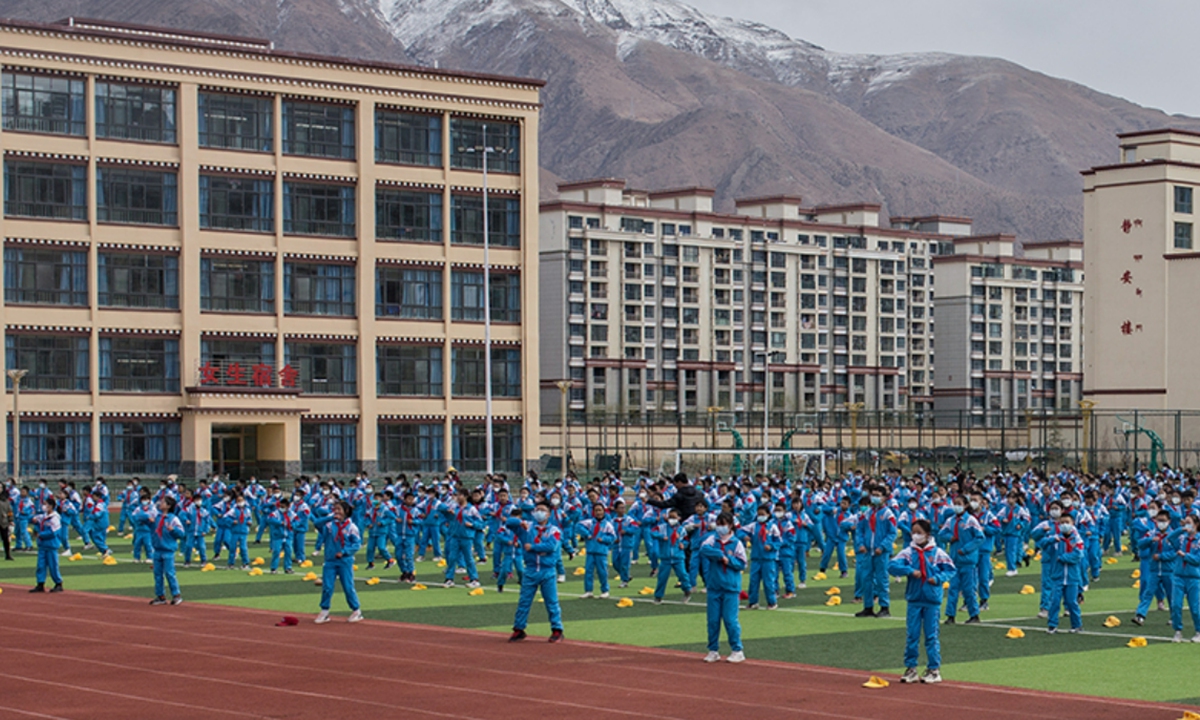By Hong Tao Source:Global Times 2023-11-23

Students in the No.1 Primary School in Lhasa, Southwest China's Xizang Autonomous Region Photo: Shan Jie/GT
In general, Xizang is considered the least developed, most backward, most remote and most unique region in China. It would seem that the central government has only made one-way investments in Xizang, with no direct returns other than the region's defense and ecological values being harnessed. However, this is not the case. A series of innovative policies that break the norm in China were first implemented in Xizang before being promoted nationwide. In this sense, Xizang's exploration has been ahead of other provinces and autonomous regions, becoming an "experimental field" for promoting and expanding China's modernization.
In 1980, the State Council announced the exemption of agricultural taxes in the Xizang Autonomous Region to help local farmers and herdsmen develop production and improve their lives. It was not until 2006 that agricultural taxes, which had existed for 2,000 years nationwide, were abolished. It created favorable conditions for China's winning the battle against poverty and completing the building of a moderately prosperous society in all respects in 2021. The important experimental significance of Xizang in this historical process cannot be ignored.
Since 1985, the Xizang Autonomous Region has implemented the "Three Guarantees Policy" of providing food, accommodation and school expenses for preschool to senior high school students from farming and herding households and impoverished urban families. Subsidy standards reached 4,200 yuan ($562) per capita annually in 2021. In 2011, Xizang achieved 15 years of free education. Local children can now attend kindergartens in villages, primary schools in towns, middle schools and high schools in county towns, and vocational schools in cities, all free of charge. They learn Xizang languages, Putonghua and English on well-equipped campuses. Children who pass the college entrance examination and go to universities in Lhasa and other mainland cities can receive various scholarships and financial aid. The education duration in Xizang leads the country, far exceeding the legally required nine years of compulsory education.
Over the past 30 years, 17 provinces and cities and 15 state-owned backbone enterprises have provided targeted support to Xizang. Since 2015, several hospitals in developed regions of China have organized hundreds of medical professionals to provide assistance in Xizang on a "group" basis. Through the expert mentoring talents model, local talents are helped and cultivated, allowing people to enjoy high-level medical services. This successful practice has been extended to provinces and regions such as Qinghai and Xinjiang. This is a vivid practice of the common unity, struggle and prosperity of all ethnic groups in China, a full display of the superiority of the socialist system, and a perfect embodiment of "Chinese modernization is the modernization of common prosperity for all."
Since entering the new era of socialism with Chinese characteristics, Xizang has firmly established the development concept that "lucid waters and lush mountains are invaluable assets and so are ice and snow." It has protected the lives and plants of the Qinghai-Xizang Plateau and the thousands of rivers and mountains. The population of precious animal species such as Tibetan antelopes, Tibetan wild donkeys, snow leopards and black-necked cranes has significantly increased. For the whole country, the ecological civilization construction on the Qinghai-Xizang Plateau occupies an irreplaceable position in responding to global climate change, achieving the "dual carbon" goal of energy conservation and emission reduction, and building a community with a shared future for mankind.
The Chinese nation is a big family composed of 56 ethnic groups, and this concept is deeply rooted in Xizang. Xizang has always been at the forefront of promoting exchanges and integration among various ethnic groups in the country. The China Tibetology Publishing House has published the Tibetan classics in Tibetan, using modern methods to publish the classic works of Tibetan masters, protecting and inheriting the excellent traditional culture of Xizang. Xizang-style songs and dances are not only widely spread in local farming and pastoral areas but are also a popular trend in big cities like Beijing and Chengdu as "square dancing." Tangka painting art, while inheriting traditional craftsmanship, has learned techniques from Chinese painting and oil painting, innovatively developing a new artistic genre of "heavy color painting in cloth" in Xizang.
Xizang plays an irreplaceable role in the process of the Chinese modernization. The protection and development of the basic human rights of people in Xizang, including the right to survival, development, education and religious culture, are achieved together with the entire Chinese people. The strategy of the central government in governing Xizang in the new era is an "experimental field" for China's modernization, a new exploration of adapting Marxism to the Chinese context, and an innovative development of socialism with Chinese characteristics in the new era. Researching, summarizing, promoting and publicizing the successful practices of governing Xizang is of great significance for building China's modernization, constructing a community with a shared future for mankind, and realizing national rejuvenation.